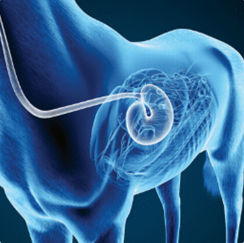Gastric Ulcers

Equine Gastric Ulcer Syndrome (EGUS) has 2 forms: squamous (ESGD) and glandular (EGGD), based on where in the stomach they are found. All horses can be affected, from foals, competition horses, pleasure horses and even our retired companions being affected by EGUS.
What are the symptoms of gastric ulcers?
The symptoms of gastric ulcers are often vague and non-specific, but the following are commonly reported:
- Behaviour change e.g. girthy or grumpy
- Colic
- Lethargic or dull
- Poor performance
- Poor body condition
To diagnose gastric ulceration, your Vet will perform a gastroscopy (a special camera that is able to look in the stomach and visualise the ulcers).
How common is gastric ulceration?
Gastric ulcers are a huge issue in competition horses. Racehorses are commonly found to have ESGD with some papers reporting 80-100% of horses in training affected. Papers have reported endurance horses during the competition season may have 66-93% of horses affected with ESGD. Although horses at home that rarely compete or leave the yard have the lowest risk of ESGD with 11% of horses reported to be affected. EGGD is less well understood but one paper found 54% of leisure horses and 64% of sport horses were affected with glandular ulceration. EGUS not only affects performance, but also affects the horse’s welfare, so clearly we need to do everything we can to support our horses to stay comfortable and ulcer free.

What can you do to reduce the risk of gastric ulcers?
Management and minimizing stress are key, with diet playing a key part. The following recommendations can help reduce the risk of gastric ulcers:
- Ensure continuous access to pasture or forage (NB speak to your Vet or nutritionist for advice if your horse is overweight or on a specific diet).
- Feed a small amount of forage or chaff to your horse 30 minutes before exercise, to reduce acid splashing. A good double handful (or 1 round scoop) of alfalfa chaff is ideal.
- Minimise the amount of starch/grain fed, ensuring each meal is not too large. Replacing some starch-based calories with vegetable oil such as Equine America Supreme Omega Oil may be appropriate. Your nutritionist or Vet will be able to give you advice specific to your horse’s requirements.
- Encourage natural foraging behaviour by offering forage in different locations in the stable.
- Ensure constant access to water.
- Routine is important, try to keep any changes in management to a minimum.
- Minimise social stressors such as bullying stable mates.
- Ensure your horse has suitable company in the form of an equine companion.
- Consider supplements such as Uls-Gard Pellets or Uls-Gard Liquid.
These recommendations are general, and specific advice relating to your horse should be sought from your Vet and/ or Equine Nutritionist.
More about Equine America Uls-Gard Pellets and Liquid:
Uls-Gard is designed to maintain digestive health and comfort using soothing and protecting ingredients for the stomach. Uls-Gard Liquid is ideal for those fussy eaters with its highly palatable formulation and can be syringed for easy administration. For more information on the key active ingredients on these products please visit the product pages on the website!
Reference:
Sykes et al. (2015) ECEIM Consensus Statement – Equine Gastric Ulcer Syndrome in Adult Horses.
 Skip to content
Skip to content

